Pride and Prejudice: The Names On Cabin John Bridge
It doesn't get noticed a lot any more, unless you're driving out MacArthur Boulevard and you have to wait your turn to use the single lane that crosses over it. The original Cabin John Bridge (not the big highway bridge that carries the Beltway over the Potomac River), lives in quiet obscurity now, just past the town of Glen Echo in Montgomery County, Maryland. But it was once an engineering marvel too important for a well-rounded sightseer to miss. The relative profusion of early twentieth-century postcards depicting the bridge, such as the ones shown here, attests to its former prominence. And maybe this is why people once had such strong feelings about whose names should be on it.
Also known as the Union Arch Bridge, it was constructed between 1857 and 1863, under the supervision of Captain Montgomery C. Meigs of the Army Corps of Engineers, who was also in charge of overseeing the expansion of the U.S. Capitol building and the replacement of its dome. The bridge was at the time the longest masonry single-span arch (at 220 feet) in the world and is still reportedly the longest in the United States. Its simple, graceful design includes sidewalls of rusticated Massachusetts granite and Seneca sandstone trim. The bridge is the most striking element of the Washington Aqueduct system, which has been carrying water from the Potomac at Great Falls to downtown Washington for over 140 years.
It all began on Christmas Eve in 1851, when a fire destroyed a room on the west front of the Capitol that housed the Library of Congress. Many priceless books and files as well as several presidential portraits were lost when there wasn't enough water available to put out the flames. At the time, the city had no effective water system; water was obtained either from natural springs or from wells. Congress reacted by funding an effort in 1852 to develop a system for delivering to Washington and Georgetown "an unfailing and abundant supply of good and wholesome water."
Enter Montgomery C. Meigs. Meigs, who was born in Georgia but raised in Pennsylvania, was a man of exceptional drive, intellect, irascibility, and arrogance, who had been fascinated by engineering from an early age. When he was but six years old, his mother described him as "high-tempered, unyielding, tyrannical toward his brothers, and very persevering in pursuit of anything he wishes." He graduated fifth in his class of 49 at West Point (the best engineering school at the time) and, among other western assignments, assisted Lt. Robert E. Lee, whom he greatly admired, in surveying the Mississippi River before he was called to Washington in 1852. Here he met and married Louisa Rodgers, daughter of the distinguished Commodore John Rodgers, who had an imposing house on Lafayette Square and formerly had resided at Georgetown's Dumbarton House. Connections such as this undoubtedly helped Meigs gain the prominence and respect to be assigned the high-profile project of engineering the city's new aqueduct system. Meigs would later go on to serve as Quartermaster General during the Civil War and afterward to design and build the great red-brick Pension Building on Judiciary Square.
In a recent article, the Washington Post's Answer Man, John Kelly, discussed recent research into who should be credited with the Cabin John Bridge's daring and innovative single-arch design. Kelly presented the argument that the real designer was Alfred L. Rives, one of Meigs' assistants. Rives (pronounced "reeves") was a brilliant young engineer who had been trained at the prestigious French Ecole des Ponts et Chausees. Meigs, recognizing his talent, took him on as a close understudy in 1855 and put him in charge of the Cabin John Bridge construction in 1857. Meigs had originally envisioned a more conservative bridge with multiple arches over Cabin John Creek. It is now clear, based on the details of the final design and how it was engineered, that Rives came up with the plan for the grand single-span arch, which Meigs clearly liked very much and heartily endorsed. But Rives' name does not appear on the bridge, despite the fact that Meigs directed in March 1861 that "Assistant Engineer Alfred L. Rives C.E." be inscribed under his own name on a stone tablet on one of the bridge's abutments. Instead the tablet says "Esto Perpetua" ("This Forever") under Meigs' name alone.
It seems that Meigs just couldn't forgive anyone he saw as betraying himself or his country. Rives had done just that when he resigned his position in April 1861, after his native Virginia seceded from the Union, to become Assistant Chief Engineer of the Confederate Army. It was apparently because of this, historians surmise, that Meigs changed his orders for the bridge inscription. This certainly fits with Meigs' character; after all, Meigs was the one who later came up with the idea of burying Union dead all around Robert E. Lee's Arlington mansion so the Confederate general would never be able to live in the place again (something the Supreme Court eventually ruled was illegal). So this explanation seems to fit, although it leaves other questions unanswered.
The biggest lingering question has to do with the bridge's other major inscription, on the opposite abutment. Here we have the names of the President and Secretary of War in 1853, when work was begun, and in 1861, when the bridge was finished. It just so happens that the Secretary of War in 1853 was none other than Jefferson Davis, the future president of the Confederacy. Davis became Confederate president in February 1861, even earlier than Rives' defection, and yet Meigs, surprisingly, did nothing to prevent Davis' name from being inscribed on the bridge. It was only after Meigs moved on to the Quartermaster General post in 1862 and the bridge project was turned over to the Department of the Interior that Secretary Caleb Smith ordered Davis' name to be removed. It seems members of Congress had objected to the traitor's name being so prominent on the Union Arch.
A drawing of the inscription on the west bridge abutment as it looked in February 1909, from the Washington Post.
The inscription was removed in about June 1862 and remained excised for another four decades. Then in 1907 Rep. Adolph Meyer of Louisiana began agitating to have Davis' name reinstated. Views were split about the advisability of doing so. A letter to the Brooklyn Eagle stated, "It was foolish to remove the name; it will be silly to replace it." Another writer, to the Washington Post, averred, "I hated Jefferson Davis worse than the devil hates holy water, but I hope to live to see his name restored on the tablet." The second writer got his wish when Theodore Roosevelt, as one of his last acts as President, ordered the name put back. James B. Horne, an eccentric stonecarver from Mississippi who sang as he worked atop precarious scaffolding, took on the task in 1909 of chiseling down the entire inscription and then re-carving it with Jefferson Davis' name restored.
Compared to all the public debate about the Jefferson Davis inscription, the controversy over Alfred Rives was much quieter. An article in Lippincott's Magazine in 1883 first publicly asserted that Rives had been the one to come up with the single-arch design for the bridge. Meigs responded by strongly denying the accusation, firmly stating that "the bridge is my sole work." When Rives died in 1903, the Washington Post ran an article pointing out that Rives deserved more credit for the bridge, but there was never any push to make changes in the inscriptions.
These aren't the only changes that were made to the names on the Cabin John Bridge, however. In the late 1850s Meigs began incurring the enmity of Secretary of War John B. Floyd, who wanted the lucrative contracts for the construction of the aqueduct diverted to his friends. In September 1860, Floyd had Meigs transferred to Florida to get him out of the way so he could put his own people in charge of the project. However, Floyd soon had to resign in disgrace, and the new secretary brought Meigs back in February 1861. In the mean time, the names of Capt. Henry W. Benham and Lt. James Morton, the replacement engineers, had been carved on to the bridge. Meigs ordered the usurpers' names cut out and his own inscribed in their place.
Regardless of all the sturm und drang over name inscriptions, the bridge is clearly very well engineered and continues to carry water into the city to this day. Perhaps, thinking of the long term, one could criticize the choice of Seneca sandstone, which has not had the same durability as the Massachusetts granite. Pieces of sandstone fell from the bridge on to the Cabin John Parkway in early 1975, prompting officials to close off both the bridge and the parkway below. The communities that were connected by the bridge became isolated from each other as bureaucrats argued over who should pay for repairs. The Army Corps of Engineers finally completed restoration in December 1976. The bridge was closed again for four months in 2001 as the Corps did further restoration work, including replacing the sandstone parapets.
Also known as the Union Arch Bridge, it was constructed between 1857 and 1863, under the supervision of Captain Montgomery C. Meigs of the Army Corps of Engineers, who was also in charge of overseeing the expansion of the U.S. Capitol building and the replacement of its dome. The bridge was at the time the longest masonry single-span arch (at 220 feet) in the world and is still reportedly the longest in the United States. Its simple, graceful design includes sidewalls of rusticated Massachusetts granite and Seneca sandstone trim. The bridge is the most striking element of the Washington Aqueduct system, which has been carrying water from the Potomac at Great Falls to downtown Washington for over 140 years.
It all began on Christmas Eve in 1851, when a fire destroyed a room on the west front of the Capitol that housed the Library of Congress. Many priceless books and files as well as several presidential portraits were lost when there wasn't enough water available to put out the flames. At the time, the city had no effective water system; water was obtained either from natural springs or from wells. Congress reacted by funding an effort in 1852 to develop a system for delivering to Washington and Georgetown "an unfailing and abundant supply of good and wholesome water."
Enter Montgomery C. Meigs. Meigs, who was born in Georgia but raised in Pennsylvania, was a man of exceptional drive, intellect, irascibility, and arrogance, who had been fascinated by engineering from an early age. When he was but six years old, his mother described him as "high-tempered, unyielding, tyrannical toward his brothers, and very persevering in pursuit of anything he wishes." He graduated fifth in his class of 49 at West Point (the best engineering school at the time) and, among other western assignments, assisted Lt. Robert E. Lee, whom he greatly admired, in surveying the Mississippi River before he was called to Washington in 1852. Here he met and married Louisa Rodgers, daughter of the distinguished Commodore John Rodgers, who had an imposing house on Lafayette Square and formerly had resided at Georgetown's Dumbarton House. Connections such as this undoubtedly helped Meigs gain the prominence and respect to be assigned the high-profile project of engineering the city's new aqueduct system. Meigs would later go on to serve as Quartermaster General during the Civil War and afterward to design and build the great red-brick Pension Building on Judiciary Square.
In a recent article, the Washington Post's Answer Man, John Kelly, discussed recent research into who should be credited with the Cabin John Bridge's daring and innovative single-arch design. Kelly presented the argument that the real designer was Alfred L. Rives, one of Meigs' assistants. Rives (pronounced "reeves") was a brilliant young engineer who had been trained at the prestigious French Ecole des Ponts et Chausees. Meigs, recognizing his talent, took him on as a close understudy in 1855 and put him in charge of the Cabin John Bridge construction in 1857. Meigs had originally envisioned a more conservative bridge with multiple arches over Cabin John Creek. It is now clear, based on the details of the final design and how it was engineered, that Rives came up with the plan for the grand single-span arch, which Meigs clearly liked very much and heartily endorsed. But Rives' name does not appear on the bridge, despite the fact that Meigs directed in March 1861 that "Assistant Engineer Alfred L. Rives C.E." be inscribed under his own name on a stone tablet on one of the bridge's abutments. Instead the tablet says "Esto Perpetua" ("This Forever") under Meigs' name alone.
It seems that Meigs just couldn't forgive anyone he saw as betraying himself or his country. Rives had done just that when he resigned his position in April 1861, after his native Virginia seceded from the Union, to become Assistant Chief Engineer of the Confederate Army. It was apparently because of this, historians surmise, that Meigs changed his orders for the bridge inscription. This certainly fits with Meigs' character; after all, Meigs was the one who later came up with the idea of burying Union dead all around Robert E. Lee's Arlington mansion so the Confederate general would never be able to live in the place again (something the Supreme Court eventually ruled was illegal). So this explanation seems to fit, although it leaves other questions unanswered.
The biggest lingering question has to do with the bridge's other major inscription, on the opposite abutment. Here we have the names of the President and Secretary of War in 1853, when work was begun, and in 1861, when the bridge was finished. It just so happens that the Secretary of War in 1853 was none other than Jefferson Davis, the future president of the Confederacy. Davis became Confederate president in February 1861, even earlier than Rives' defection, and yet Meigs, surprisingly, did nothing to prevent Davis' name from being inscribed on the bridge. It was only after Meigs moved on to the Quartermaster General post in 1862 and the bridge project was turned over to the Department of the Interior that Secretary Caleb Smith ordered Davis' name to be removed. It seems members of Congress had objected to the traitor's name being so prominent on the Union Arch.
A drawing of the inscription on the west bridge abutment as it looked in February 1909, from the Washington Post.
The inscription was removed in about June 1862 and remained excised for another four decades. Then in 1907 Rep. Adolph Meyer of Louisiana began agitating to have Davis' name reinstated. Views were split about the advisability of doing so. A letter to the Brooklyn Eagle stated, "It was foolish to remove the name; it will be silly to replace it." Another writer, to the Washington Post, averred, "I hated Jefferson Davis worse than the devil hates holy water, but I hope to live to see his name restored on the tablet." The second writer got his wish when Theodore Roosevelt, as one of his last acts as President, ordered the name put back. James B. Horne, an eccentric stonecarver from Mississippi who sang as he worked atop precarious scaffolding, took on the task in 1909 of chiseling down the entire inscription and then re-carving it with Jefferson Davis' name restored.
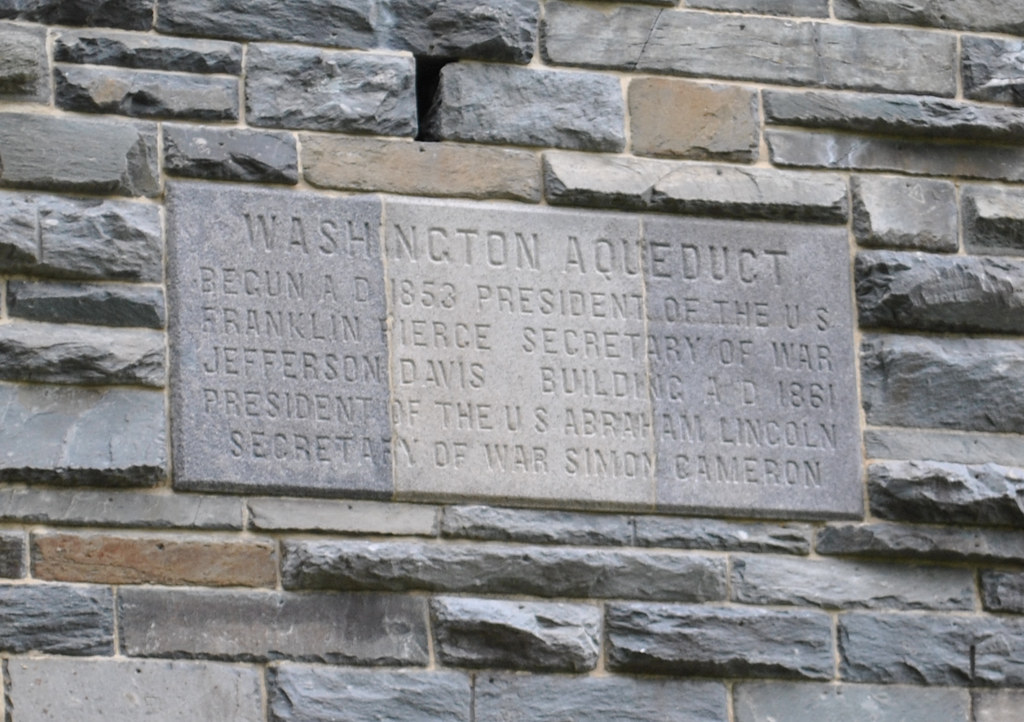 |
| The west abutment inscription as it appears today. |
Compared to all the public debate about the Jefferson Davis inscription, the controversy over Alfred Rives was much quieter. An article in Lippincott's Magazine in 1883 first publicly asserted that Rives had been the one to come up with the single-arch design for the bridge. Meigs responded by strongly denying the accusation, firmly stating that "the bridge is my sole work." When Rives died in 1903, the Washington Post ran an article pointing out that Rives deserved more credit for the bridge, but there was never any push to make changes in the inscriptions.
These aren't the only changes that were made to the names on the Cabin John Bridge, however. In the late 1850s Meigs began incurring the enmity of Secretary of War John B. Floyd, who wanted the lucrative contracts for the construction of the aqueduct diverted to his friends. In September 1860, Floyd had Meigs transferred to Florida to get him out of the way so he could put his own people in charge of the project. However, Floyd soon had to resign in disgrace, and the new secretary brought Meigs back in February 1861. In the mean time, the names of Capt. Henry W. Benham and Lt. James Morton, the replacement engineers, had been carved on to the bridge. Meigs ordered the usurpers' names cut out and his own inscribed in their place.
Regardless of all the sturm und drang over name inscriptions, the bridge is clearly very well engineered and continues to carry water into the city to this day. Perhaps, thinking of the long term, one could criticize the choice of Seneca sandstone, which has not had the same durability as the Massachusetts granite. Pieces of sandstone fell from the bridge on to the Cabin John Parkway in early 1975, prompting officials to close off both the bridge and the parkway below. The communities that were connected by the bridge became isolated from each other as bureaucrats argued over who should pay for repairs. The Army Corps of Engineers finally completed restoration in December 1976. The bridge was closed again for four months in 2001 as the Corps did further restoration work, including replacing the sandstone parapets.
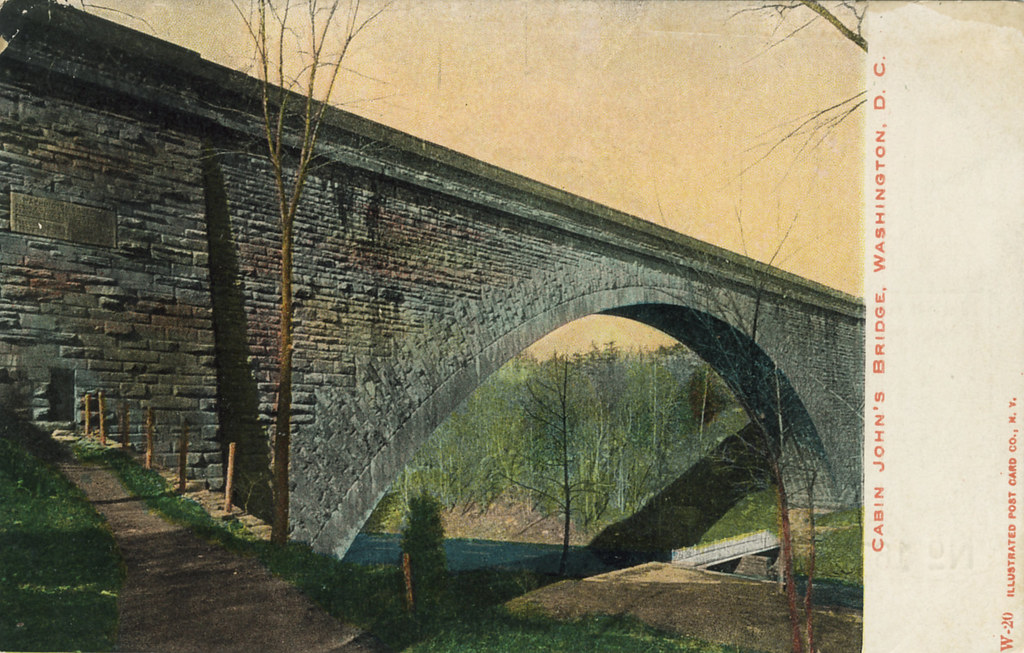
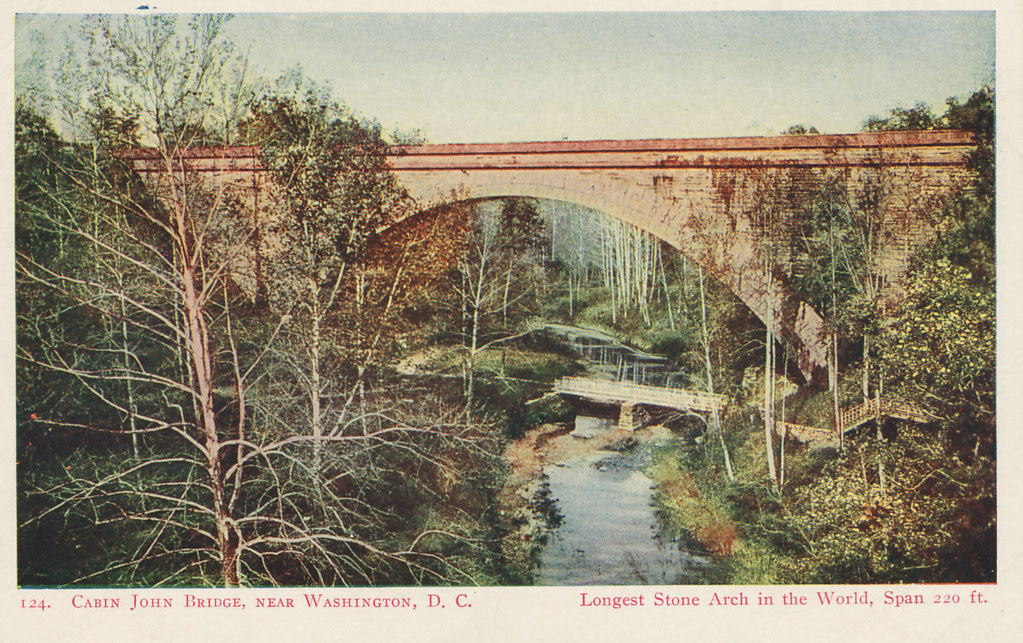

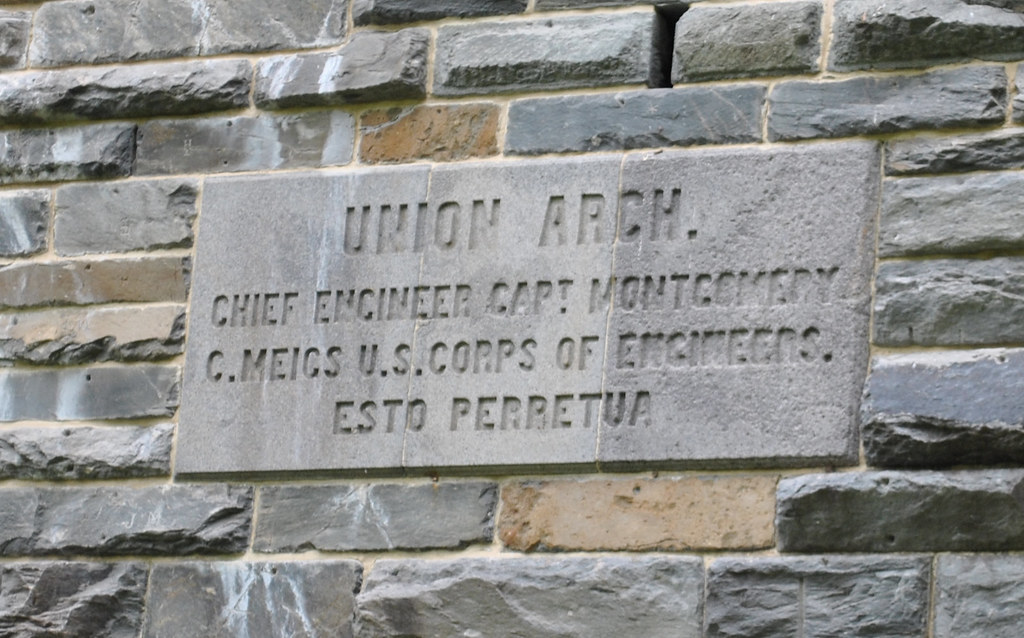

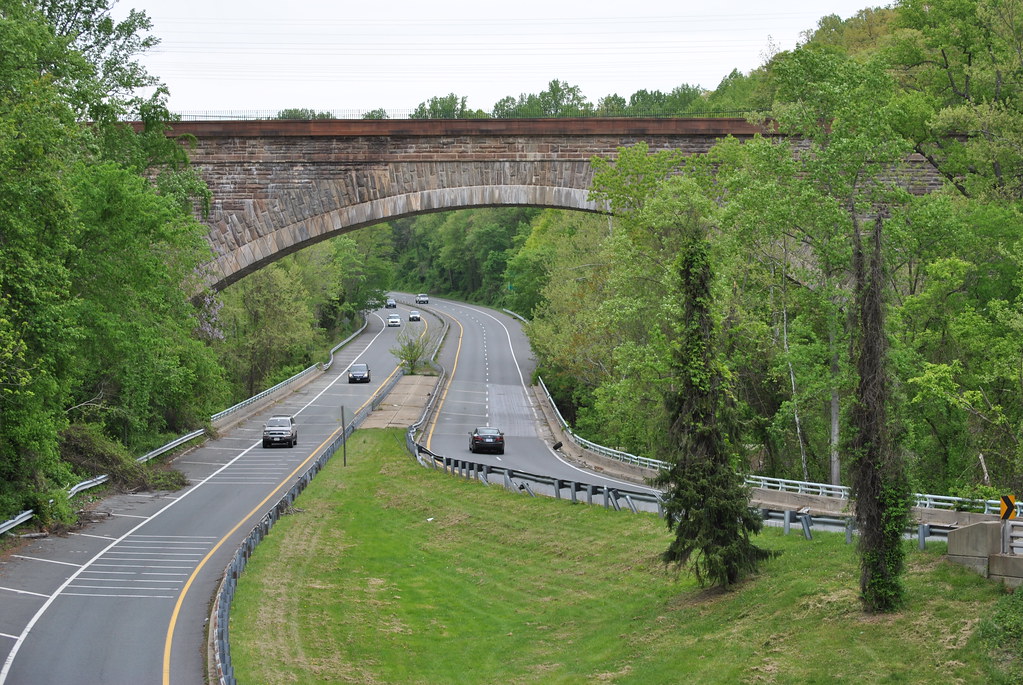


Who provided the labor for this project overseen by the US Army Corp of Engineers
ReplyDeleteContractors, many of whom used slave labor for the heavy work and Irish and Italian craftsmen for dressing the stone. The government, however provided meals for all the workers and Meigs, who hated slavery, feed them all in an integrated dining facility.
ReplyDeleteBill Dickinson, editor of Montgomery C. Meigs and the Building of the Nation's Capital.
Probably the same people that built the Pyramids & Stonehenge.
ReplyDelete